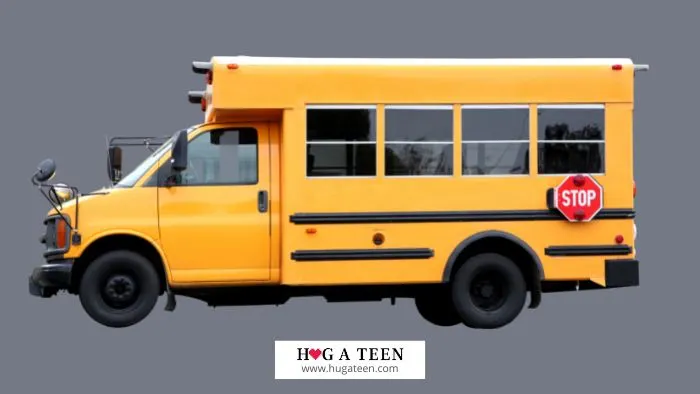Your morning school ride is probably not something you think about all the time, but you may have wondered how much your school bus weighs.
If so, read on to find out how much a school bus weighs and how much weight it can carry.
How much does a school bus weigh?

A school bus weighs around 10,000 to 25,000 pounds when empty. It can weigh between 14,500 pounds to 36,000 pounds when full. The weight of the bus highly depends on the type of bus as the different types have various components that contribute to the overall weight.
Factors determining a school bus’s weight include:
- Length
- Number of seats and passengers
- Construction material
- Storage capacity
- Gas tank size
All the above key factors contribute to the overall weight of a school bus, explaining why there is no exact or definitive weight for a school bus. Although you can find an average weight for each bus model, the actual weight will vary.
How many tons does a school bus weigh?
A school bus can weigh between 5 and 15 tons, depending on the size. An average school bus weighs between 7 and 9 tons, small buses weigh less than 7 tons, and big ones weigh between 11 and 15 tons.
How much weight can a school bus hold?
A school bus can hold between 10,000 pounds and 36,000 pounds. The weight a bus can carry depends on its carrying capacity in terms of passengers and the type of bus. Large school buses’ gross vehicle weight rating (GVWR) can reach 36,000 pounds. The GVWR of small school buses is typically in the range of 10,000 pounds. This would be the weight of a fully loaded school bus since the GVWR includes the additional weight of the school kids.
How much weight can a school bus tow?
The amount of weight a bus can tow is determined by the sizes of school buses. A smaller school bus can tow a load of 5,000 pounds, but some models can tow up to 18,000 pounds. The towing weight is determined by dividing the weight of the vehicle by two. For example, if a bus weighs 20,000 pounds, its towing weight should be 10,000 pounds or less.
Check your vehicle’s gross weight rating (GVWR) in your owner’s manual or manufacturer’s website to determine its towing capacity.
Types of School Buses
School buses are classified into different types according to the number of passengers they can carry and their overall size.

Type A is the smallest type of bus; it resembles a van and can carry just over ten passengers. Type A buses are further classified into Type A-1 and Type A-2. Type A-1 carries up to 10 passengers, while Type A-2 can carry up to 24.

Type B bus is also known as a half-bus and looks more like a truck with a bus attached to the back. It has a short front end and an extended back. Type B buses are more extensive than type A but almost the same size as Type A-2. It can hold between 10 to 24 passengers.

Type C buses are the most typical or conventional school buses that people are familiar with. It has a long front and an even longer back. It is big enough to accommodate up to 72 passengers and is the largest type of school bus.

Type D bus is similar to Type C in size and passenger capacity. The only difference is that a Type D bus has a flat front instead of a long front. The flat-front, transit-style models design allows the door to be placed ahead of the front wheels instead of behind them like other buses.
Type D buses are common in major cities and are designed to take up less space without compromising on their capacity. Type D’s are the biggest school buses and can hold up to 80 passengers and measure out to 45 feet in length.
How much does a type A school bus weigh?
The average school bus weight of the type-A school bus is around 10,000 pounds when empty. At full capacity, this bus can weigh between 14,500 pounds (7.5 US tons) and 21,500 pounds. This depends on the number of passengers it carries, with the smaller one holding up to 10 and the bigger one accommodating up to 24.
How much does a type B school bus weigh?
A type B school bus weighs about 10,000 pounds when empty. It is similar to the bigger type A bus, which, when full, holds about 21,500 pounds. The total weight depends on the number and weight of passengers on the bus.
How much does a type C school bus weigh?
A type C school bus weighs about the same as when a type A or B bus is full. A type C bus can weigh between 15,500 pounds and 21,500 pounds when empty. At total capacity, this bus can weigh between 25,000 pounds and 30,000 pounds. This equates to about 14 tons.
How much does a type D school bus weigh?
A type D school bus weighs about the same as type C, which is between 15,500 to 21,500 pounds when empty. When full, this bus can weigh between 25,000 to 30,000 pounds. It can weigh more if it is carrying more passengers and luggage.
Type D school buses, characterized by their flat fronts and transit-style layouts, can carry up to 80 passengers and measure about 45 feet in length.
| School Bus Type | Weight Empty (lb) | Weight Full (lb) | Passengers |
|---|---|---|---|
| TypeA-1 | 10,000 | 14,500 | 10 |
| Type A-2 | 10,000 | 21,500 | 24 |
| Type B | 10,000 | 21,500 | 24 |
| Type C | 15,500 - 21,500 | 25,000 - 30,000 | 72 |
| Type D | 15,500 - 25,000 | 25,000 - 36,000 | 80 |
School Bus Facts
How long is a school bus?
A school bus can be as short as 20 feet and as long as 45 feet. Small type-A buses measure around 20 feet in length, while bigger Type C and D buses measure up to 45 feet. Most larger school buses are about 7.5 feet wide on the inside.
How much do school bus drivers make?

The salary for bus drivers working throughout the academic school year (9 months) depends on the state and their daily work hours.
School bus drivers make an average of $37,000 per year. The salaries can range between $15,000 to $67,000. The best-paid 25 percent earned just over $60,000 that year, while the lowest-paid 25 percent made below $35,000.
Find out more about bus driver pay and hourly schedules in the video below:
How much does a school bus cost?
A new school bus costs between $90,000 to $290,000, depending on the type and size of the bus.
According to Skoolielivin, a used school bus can cost between $4,000 to $10,000 for a bus with 120,000 – 180,000 miles. The price of a used school bus for sale with 20,000-50,000 miles can range from $15,000 to $40,000.
If you want to repurpose a used school bus and use it as a camper, you can expect to pay around $20,000 to $30,000 for appliances, equipment, tools, and raw materials.
Why are school buses yellow?
The yellow color was adopted as the standard color for school buses at a national conference of school transportation in 1939. School buses are yellow to ensure they are easily visible in dim or bright light. The bright yellow school bus color is meant to get the attention of pedestrians and drivers on the road. The yellow color makes it easy for school buses to be seen from a distance, even in foggy weather. Another reason why buses are yellow is that safety laws in some areas require that the buses be yellow, making them one of the most recognizable vehicles on the road.
How many seats on a school bus?
The number of seats on a school bus depends on the type of bus. Type A buses have between 10 to 24 seats, type B buses have up to 72 seats, type C buses have 80 seats, and bigger type D buses have up to 90 seats.
Why don’t school buses have seatbelts?

School buses don’t have seatbelts because they are the most regulated vehicles on the road. They are designed to be safer than other vehicles and follow a set of rules to ensure students are safe without the need for safety belts on school buses. However, a passive form of occupant protection called compartmentalization, which is a close-spaced, energy-absorbing padded seating design, has been required on school buses since 1977.
There is an ongoing debate and consideration by many states to implement three-point belts in school buses, but this school bus seat belt legislation has not been passed. The only state requiring school buses to use three-point belts is California. Three other states require lap belts: Florida, New Jersey, and New York.
How much does a used school bus cost?
A used school bus with 120,000 to 180,000 miles can cost anywhere between $4,000 to $10,000. Buses with 20,000 to 50,000 miles can cost between $15,000 to $40,000 or more. The cost will depend on the type of the bus and the condition it comes in.
What engine does a school bus have?
Most school buses come with diesel engines. This is because diesel engines are more reliable, durable, and safer than others. Diesel engines are also energy efficient and more flexible to operate, making them ideal for the regular use of school buses.
When is school bus driver appreciation day?
October 24 is School Bus Driver Appreciation Day. On this day, we recognize the many dedicated school bus drivers for ensuring children get to school and back home safely.
When were school buses invented?
School buses were invented in 1915 by International Harvester, who was succeeded by Navistar, a company that still produces school buses. School bus usage was funded in 48 US states in 1919, but the history of school buses can be traced as far as 1886, when Wayne Works made horse carriages known as school hacks.
